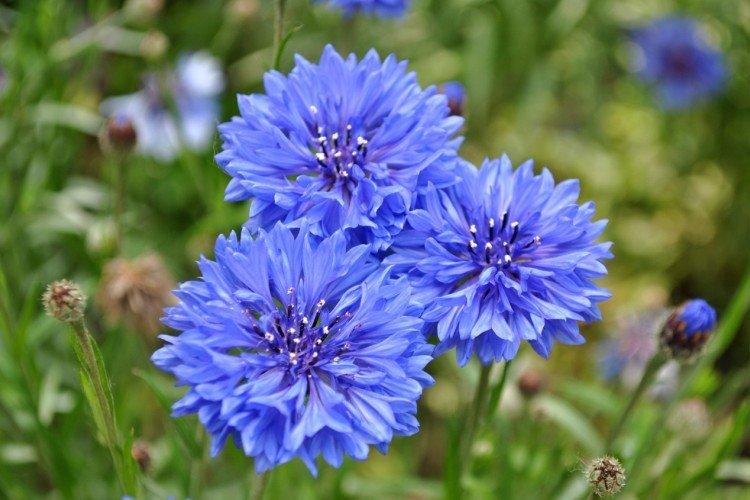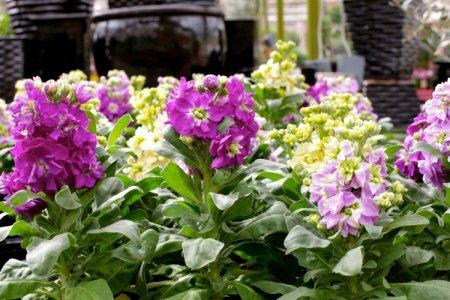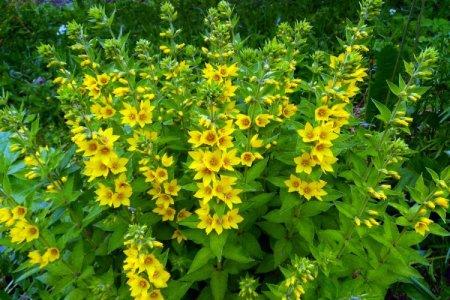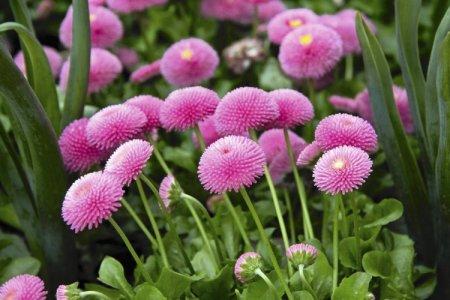
Delicate and charming cornflowers are a constant symbol of spring, summer and long-awaited warmth. They look spectacular at home on the table, but even better - in the garden or flower bed. We will tell you how to grow cornflowers, what is needed for this, and how to care for them in general!
general information
Cornflowers are found throughout Europe, decorating lawns and flower beds in areas and in cities. They also grow in the wild, where our distant ancestors noticed it and began to use it as a medicinal plant.
The bright flowers of a cornflower are large inflorescences-baskets of individual small flowers, similar to petals. In addition to blue and blue varieties, there are white, pink, yellow and burgundy.
Cornflower is a herb, but not always small, because some species can grow over a meter. Among them there are annuals and perennials, and in natural conditions they grow almost like weeds.
Basically, the stems of cornflowers are erect or recumbent, and the leaves can be whole or strongly dissected. The inflorescences are collected in several pieces, due to which wonderful bouquets are obtained from cornflowers. Otherwise, it is rather problematic to derive a single general description due to the diversity of the genus.

Types of cornflowers
Only on the territory of Russia there are about 180 species that belong to the genus of cornflowers. In fact, there are many more of them, but we'll start with the main ones!
Blue cornflower
The most popular and widespread in our latitudes. It is grown as an annual or, less commonly, as a biennial plant. Erect stems, silvery leaves and single basket inflorescences are a blue cornflower.

Pink cornflower
And again, the name speaks for itself, so that its peculiarity is single pink inflorescences about 5 cm in diameter. The leaves and shoots of pink cornflowers are slightly lighter.

Field cornflower
Herbaceous annual with delicate blue-blue baskets that bloom in late spring. It is often planted in flower beds in group compositions.

Meadow cornflower
Perennial herbaceous species with stiff and straight tall stems. The inflorescences of such cornflowers are usually white or pinkish, and the leaves and shoots seem to be covered with a silvery bloom.

Large-headed cornflower
One of the tallest species up to 120 cm in height and with large yellow inflorescences up to 7 cm in diameter. The large-headed cornflower blooms by mid-summer.

White cornflower
It is distinguished not only by white color, but also by voluminous terry inflorescences about 4 cm in diameter. But this species is listed in the Red Book throughout Europe.

Cornflower care
If you choose the right plot for cornflowers, then even an inexperienced beginner can easily cope with leaving. For all its visual fragility, the plant almost does not cause trouble!
Temperature and lighting
Cornflowers are thermophilic, so they need a warm and bright area without drafts. It is important that they do not shade themselves, so when planting, leave 15-50 cm between the bushes, depending on the size of the variety.

Watering
Cornflowers do not tolerate stagnant water in the ground very badly, so they should not be poured. They will grow poorly in areas with a close occurrence of groundwater. Additional moderate watering is necessary only in the absence of rain for a long time.

The soil
The ideal soil for cornflowers is light loam. You also need to get rid of excessive acidity, so add lime to the soil as needed in the fall. Sawdust or sand is suitable as a baking powder.

Fertilizers and feeding
Cornflowers need top dressing mainly to extend the flowering period, so pay attention to potash-phosphorus mixtures. It is enough to use complex preparations once every 2-3 weeks when watering.

Pruning
Cornflowers grow strongly and actively reproduce by self-seeding, therefore, periodically plantings need to be thinned and cut. There are two types of trimming - low and high. At a low one, no more than 10 cm of shoots remain, and in the end this has an excellent effect on the aesthetics of the flower bed. When tall, the stems are shortened right in front of the inflorescences, and this method is better for beginners.

Wintering
Perennial varieties easily overwinter outdoors in the middle lane and even to the north. Most of them do not require shelter and do not pose any problems at all. It is enough to cut the bushes shortly before winter.

Planting and breeding
Cornflowers in their natural environment reproduce well by self-seeding. But for a decorative flower bed, the seedling method is better suited. By the end of March, plant the seeds in moist soil, lightly sprinkle with earth and leave warm under a film until germination.
After emergence, remove the film and move the containers to the light. When 2 leaves appear among the seedlings, leave the strongest ones, and pinch the rest at ground level. They can be transplanted into the garden when they grow up to 10 cm.
Seeds can be sown directly into open ground, but not earlier than by the beginning of May, when the threat of frost has passed. Seedlings will appear in a couple of weeks. And perennial varieties can be planted with seeds before winter, when the ground is already slightly frozen.
At the end of summer, cornflowers can be propagated by dividing the bush. The mother plant must be carefully dug up, washed, cut off all excess shoots and the healthy part with at least three buds must be separated. After that, cornflowers need to be planted, cut to 10 cm and watered regularly.

Pests and diseases of cornflowers
Cornflowers rarely get sick and are almost not afraid of pests. They have only two main problems - fungus and mites. The most common fungal disease is fusarium, from which the leaves are rapidly deteriorating. It is necessary to remove all affected areas, disinfect the sections and treat the planting with fungicides.
Spider mites reproduce intensively in hot and dry weather. The leaves turn yellow, and the plants are completely covered with a whitish bloom-cobweb. Special insecticides or spraying with ordinary soap solution help with ticks.

Cornflowers - photo
Just look at how spectacular and bright simple and unassuming cornflowers can be!





























